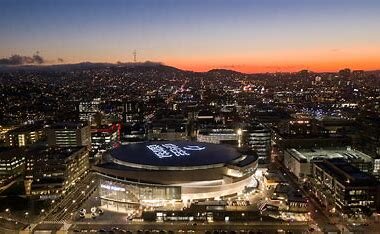Why are billion dollar sports stadiums being built with public money in US cities with the WORST housing affordability?

Photo above - San Francisco's Chase Center arena. Home to the Golden State warriors, and signature Hennessey V.S.O.P and Moet & Chandon cocktails (the Golden 75) . . . and the nation's worst home affordability index. Silicon Valley Tech Moguls with property tax breaks made it happen.
‘The stadium is secondary’: how US sports teams became real-estate speculators | US sports | The Guardian
Quick . .. where is America's MOST EXPENSIVEST sports stadium? Go to the head of the class if you know it's SoFi Stadium, in Los Angeles. Home of the Rams AND the Chargers. Completed in 2020. Cost? $5 Billion!!! WTH!!! That's $72,000 per seat!! How much of that was public money (tax credits, land grants, road improvements, utilities upgrades, etc)? Websites disagree, but they got a LOT! The stadium operators admit to $100 million in tax relief. Who knows what they DONT admit to? Los Angeles has the worst housing affordability index in America, except possibly for . . .
San Francisco, where the Chase Center – home to the Golden State Warriors - was completed in 2019. But the Warriors' Arena “only” cost $1.5 billion. Because it's a basketball court, it has fewer seats, then it should be cheaper, right? The construction cost per seat is even higher though – about $85,000 per. Oh, and they built the Levi's Stadium in SF (49ers) for $1.4 billion in 2014. Bet you couldn't build it for that today, after all the inflation, eh?
New York, New York . . . has the Barclays Center (Nets) and the Met Life Stadium (Giants and Jets, both losers), but technically that's on the NJ side of the river.
Oddly enough, even though Las Vegas built TWO giant stadiums in the past 5 years, neither of them were tagged by casinos for naming rights. Allegiant Stadium and T-Mobile Arena. But I'm not claiming that Las Vegas has the worst housing affordability problems. Land is flatter, cheaper, and less regulated near Vegas.
So . . . billions and billions for stadiums. Big public money involved. And people chillin' in tents on the sidewalks nearby. The rationale for public financing of sports venues is always the same: JOBS!! Yeah . . . um . . . food vendors? Janitors? Parking attendants? Security guys? Where do THEY live? 50 miles away, where someone has a prayer of getting a 2 bedroom walk up for less than $5,000 a month?
In some cases local politicians will remind us that a funding referendum was held. Or a public hearing during a city council meeting. Both special interest AND voter opinion was obtained. Nobody wants to see their local team pack up and leave due to having tacky, outdated skyboxes. Well, maybe the Giants and Jets, who ended up in NJ. But look how well most of the other teams are doing!
There is, of course, no guarantee that “stadium money” would have been used for affordable housing, even if rational decisions had been made on how to spend tax dollars. Politicians suffer from a crisis of confidence when it comes to public opinion. They routinely vie with personal injury lawyers, used car salesmen, and cable TV newscasters for dishonesty rankings.
Let's look at the bright side, though. Hot dog vendors at the Los Angeles SoFi stadium are getting the new $20 per hour minimum wage, as of January 1st. But do they work enough hours selling beer and hot dogs (or sushi – this is Los Angeles!) to make ends meet? I suspect some are working 2nd and 3rd gigs. Amazon picker, Uber, Door Dash, whatever. And the rest? They might be living in tents.
I'm just sayin' . . .




